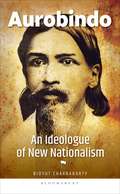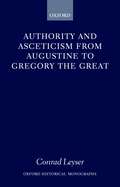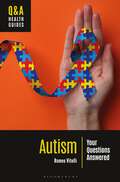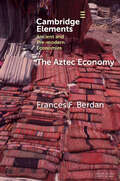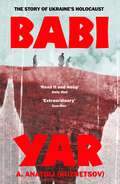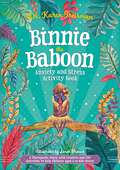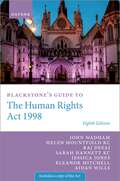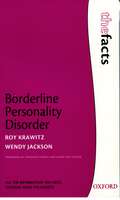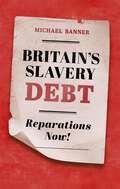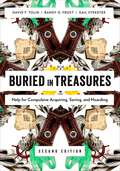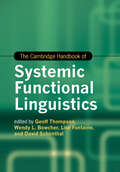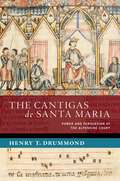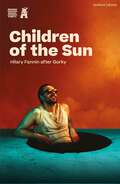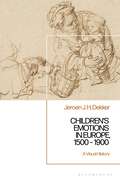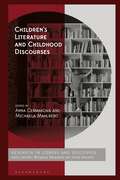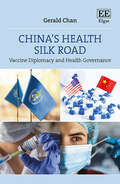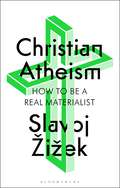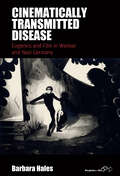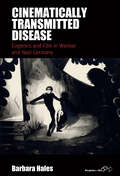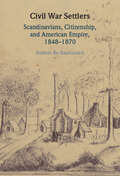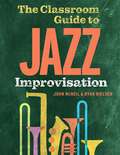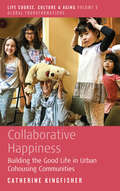- Table View
- List View
Aurobindo: An Ideologue of New Nationalism
by Bidyut ChakrabartyThis book elaborates the politico-ideological viewpoints of Aurobindo, as displayed when he reigned as one of the major nationalist leaders defining Indian nationalism. Bidyut Chakrabarty examines Aurobindo's politico-ideological ideas during the period (1893-1910) when he was an active participant in the 'New Nationalist' or 'Democratic Nationalist' campaign, which started with the bifurcation of the Indian National Congress between the Moderates and Extremists (also known as the Revolutionary Nationalists) in its 1907 annual session, held at Surat.Chapters cover Aurobindo's distinctive ideas of nationalism, which he evolved in collaboration with his colleagues, especially Lal-Bal-Pal (Lala Lajpat Rai, Bal Gangadhar Tilak, and Bipin Chandra Pal), and how he redefined the practice of nationalism. The book also demonstrates that unlike his predecessors, the Moderates, Aurobindo set out many strategies - including boycott and passive resistance - to execute the distinctive plan he designed to attain his politico-ideological goal. Other topics include the relatively less discussed aspect of Aurobindo's socio-political ideas, namely his unique model of education as an antidote to many of the crippling socio-cultural prejudices, and the importance of Bhagavad Gita in shaping Aurobindo's politico-ideological priorities.
Authority and Asceticism from Augustine to Gregory the Great (Oxford Historical Monographs)
by Conrad LeyserConrad Leyser examines the formation of the Christian ascetic tradition in the western Roman Empire during the period of the barbarian invasions, c.400-600. In an aggressively competitive political context, one of the most articulate claims to power was made, paradoxically, by men who had renounced 'the world', committing themselves to a life of spiritual discipline in the hope of gaining entry to an otherworldly kingdom. Often dismissed as mere fanaticism or open hypocrisy, the language of ascetic authority, Conrad Leyser shows, was both carefully honed and well understood in the late Roman and early medieval Mediterranean. Dr Leyser charts the development of this new moral rhetoric by abbots, teachers, and bishops from the time of Augustine of Hippo to that of St Benedict and Gregory the Great.
Autism: Your Questions Answered (Q&A Health Guides)
by Romeo VitelliResearch suggests that about 1% of the world's population is on the autism spectrum. Discover the answers to common questions about living with neurodiversity.Part of the Q&A Health Guides series, this book offers a broad introduction to autism spectrum disorder (ASD). The book's 47 questions cover what ASD is and its common characteristics, the biological and environmental factors that may lead to ASD, how autism is diagnosed and managed, and how those living with ASD can reach their full potential. Autism: Your Questions Answered addresses these and other topics in a way that both celebrates neurodiversity and acknowledges the many challenges that those with ASD face.Augmenting the main text, a collection of 5 case studies illustrate key concepts and issues through relatable stories and insightful recommendations. The common misconceptions section at the beginning of the volume dispels 5 long-standing and harmful myths about ASD, directing readers to additional information in the text. The glossary defines terms that may be unfamiliar to readers, while the directory of resources curates a list of the most useful books, websites, and other materials. Finally, whether they're looking for more information about this subject or any other health-related topic, readers can turn to the guide to health literacy section for practical tools and strategies for finding, evaluating, and using credible sources of health information both on and off the Internet.
Babi Yar: The Story of Ukraine's Holocaust
by A. AnatoliThis gripping story of Kyiv during the Second World War told by a young boy who saw it all.'Rightly hailed a masterpiece' Daily Mail'So here is my invitation: enter into my fate, imagine that you are twelve, that the world is at war and that nobody knows what is going to happen next...'When the German army rolled into Kyiv in 1941 the young Anatoli was just twelve years old. He began writing down what he saw in his journals.Within ten days of the invasion, the Nazis had begun their campaign of fear and murder in Ukraine. Babi Yar (Babyn Yar in Ukrainian) was the place where the executions of Jews and many others took place. It was one of the largest massacres in the history of the Holocaust. Anatoli could hear the machine guns from his house.Anatoli’s clear, compelling voice, honesty and determination guide us through the horrors of that time. Babi Yar has the compulsion and narration of fiction but everything recounted here is true.'Extraordinary' Orlando Figes, Guardian'A vivid first-hand account of life under one of the most savage of occupation regimes... A book which must be read and never forgotten' The TimesThis is the complete, uncensored version of Babi Yar - its history written into the text. Parts shown in bold are those cut by the Russian censors, parts in brackets show later additions.
Binnie the Baboon Anxiety and Stress Activity Book: A Therapeutic Story with Creative and CBT Activities To Help Children Aged 5-10 Who Worry (Therapeutic Treasures Collection)
by Dr. Karen TreismanBinnie is an energetic baboon, who bounces around the lush green mountains of Rwanda in East Africa. But like many of us, Binnie often feels worried and stressed, and these worries can get in her way! What if she gets lost in the jungle, or her family gets sick? What if no one likes her? Sometimes she even worries about the fact she's worried; and if she isn't worried, well why not?! This activity book has been developed by expert child psychologist Dr Karen Treisman. The first part of the book is a colourful illustrated therapeutic story about Binnie the Baboon, with a focus on worry and anxiety. This is followed by a wealth of creative activities and photocopiable worksheets for children to explore issues relating to anxiety, worry, fears, and stress, and how to find ways to understand and overcome them. The final section of the book is full of advice and practical strategies for parents, carers, and professionals on how to help children aged 5-10 to start to understand why they experience feelings of anxiety, and what they can do to help reduce and navigate it.This activity book is complemented by a standalone picture book of Binnie's story, also available from Jessica Kingsley Publishers (Binnie the Baboon, ISBN 9781839970252).
Birkenhead Park: The People's Garden and an English Masterpiece
by Robert LeeWhen it was officially opened on Easter Monday, 5th April 1847, Birkenhead park became the first municipally funded park in Britain. It was a pioneer in the development of urban public parks, designed for use by everyone, irrespective of social class, ethnicity or age. In terms of town planning, it demonstrated the importance of including green infrastructure in urban development as a vital contribution to public health and wellbeing. Paxton’s design for the park was heralded as ‘a masterpiece of human creative genius’ : it served as a vehicle for the global transmission of the English landscape school and led to the creation of numerous public parks everywhere, most famously Central Park, New York, incorporating of many of Paxton’s design features. This book addresses a long-standing gap in the Park’s historiography. Regarded as ‘one of the greatest wonders of the age’, it is an important contribution to nineteenth-century landscape history with a local focus, but of international significance. But it seeks to interpret the Park’s development until 1914 within a political and cultural context, drawing on economic and social history, as a means of explaining why it was not until the late-nineteenth century that it finally became a focal point for recreation and public health.
Blackstone's Guide to the Human Rights Act 1998 (Blackstone's Guides)
by John Wadham Helen Mountfield KC Raj Desai Sarah Hannett KC Jessica Jones Eleanor Mitchell Aidan WillsBlackstone's Guide to the Human Rights Act 1998 provides clear, concise coverage of the operation and application of the Human Rights Act 1998, including the development of human rights jurisprudence in the domestic courts and in Strasbourg. It also sets out the recent erosion of the universal applicability of the remedies in the Human Rights Act by the Illegal Migration Act 2023 and other recent changes to the statutory scheme such as the amendment to the limitation period for claims involving the armed forces. The Guide considers the case law of the European Court of Human Rights and the impact of Convention rights in landmark domestic judgments across a wide range of areas, including terrorism, privacy, discrimination, and criminal law. It explains the interpretive techniques employed by the courts to read legislation compatibly with Convention rights and the jurisdiction to declare legislation incompatible with Convention rights. Finally, the last chapter sets out how to make an application to the Strasbourg Court and sets out in detail how that court works. The new edition of this popular Guide considers the key developments since the publication of the previous edition 9 years ago. It sets out recent reviews of the Human Rights Act and puts the threats to the Act, especially the Bill of Rights, in the context of the recent history of human rights in the UK. It also considers significant developments in the law relating to the extra-territorial reach and applicability of the Convention under Article 1 ECHR, following Al Skeini, Georgia v Russia, Guzelyurtlu, Hanan and HF. The book contains an up to date copy of the Human Rights Act 1998, and the text of the rights in the European Convention on Human Rights which are now a central part of UK law. The Blackstone's Guide series delivers concise and accessible books covering the latest legislative changes and amendments. Published soon after enactment, they offer expert commentary by leading names on the scope, extent and effects of the legislation, plus a full copy of the Act itself. They offer a cost-effective solution to key information needs and are the perfect companion for any practitioner needing to get up to speed with the latest changes.
Borderline Personality Disorder (The Facts)
by Roy Krawitz Wendy JacksonBorderline personality disorder (BPD) is a psychiatric condition that affects nearly 2% of the general population, predominantly women. Symptoms of BPD include impulsivity, mood swings, unstable intense relationships and feelings of chronic emptiness. Research on BPD has lagged behind that on other mental health conditions, such as depression and psychosis, primarily due to the lack of evidence of effective treatment but also due to the stigma historically associated with the condition. Fortunately this situation is changing, with improved treatments now available and improved clinician/organizational willingness to engage with those with a diagnosis of BPD. This candid book collaboratively co-authored by a person recovered from BPD and a BPD specialist therapist is written specifically for people with BPD (with support teams, including family, friends and clinicians also likely to benefit from reading the book). This authoritative and easily readable guide provides a compassionate understanding of the condition, plenty of in-depth practical recovery strategies and credible and realistic hope for recovery. The authors draw from the latest research and share years of personal and professional experience that brings the book alive. Review comments from Vice-President, National Education Alliance for BPD and Director, Middle Path (BPD advocacy organizations) include "most down-to-earth, accessible book for people with BPD" and "tremendous and potentially life-changing gift".
Britain's Slavery Debt: Reparations Now!
by Michael BannerA concise, reasoned, practical case for why Britain should pay reparations for historic wrongs to present Caribbean inhabitants. Britain owes reparations to the Caribbean. The exploitation of generations of those trafficked from Africa, or born into enslavement, to work the immensely profitable sugars plantations, enriched both British individuals and the British nation. Colonialism, even after emancipation, perpetuated the exploitation. The Caribbean still suffers, and Britain still benefits, from these historic wrongs. There are some fairly standard objections to reparations -- 'slavery ended a long time ago'; 'Britain should be celebrating its role in abolishing slavery'; 'slavery was legal back then and we shouldn't judge the past by the standards of the present'; 'you shouldn't visit the sins of the fathers on the sons'; and so on. And there is a sense that the practical problems of who should pay what to whom are immensely difficult. Michael Banner carefully considers and answers these objections. He argues that reparations are not about punishment, but about the restoration of wrongful gains. In Reparations Now! he makes a specific and practical proposal regarding reparations, picking up on the programme suggested by Caribbean countries (through CARICOM), and taking as a starting point the nearly ?20 million paid as compensation by the British government at abolition, not to those who had suffered slavery, but to those who lost enslaved labourers. Reparations Now! discusses what can be done, here and now, by individuals and institutions, to advance the case for reparations between national governments.
Building Full Stack DeFi Applications: A practical guide to creating your own decentralized finance projects on blockchain
by Samuel ZhouTake your blockchain and Web3 development skills to the next level by building real-world full-stack DeFi applications with Solidity and JavaScriptKey FeaturesGain the knowledge you need to start implementing DeFi principles in practiceLearn how to build full-stack real-world DeFi products from scratch with step-by-step instructionsLeverage tools like Hardhat, Ethers.js, Node.js, React.js, Solidity, and Web3 for effective DeFi application developmentPurchase of the print or Kindle book includes a free PDF eBookBook DescriptionEnter the world of Decentralized Finance (DeFi) with Building Full Stack DeFi Applications. Understand how this blockchain-based financial technology, designed to manage crypto assets, runs independently without centralized financial institutions like banks and brokerages, eliminating the fees that banks and other financial companies charge for using their services. This book will show you how DeFi solutions are built with smart contracts running on blockchains and how they allow users to gain and earn crypto assets based on the trust of the smart contracts. This book uncovers the inner workings of DeFi by guiding you through the mathematical foundations and teaching you how to build real-world DeFi products with Solidity and JavaScript. As you progress through the chapters, you’ll learn how to implement smart contracts of liquidity pools to trade cryptocurrencies and implement staking, including farming features that allow users to earn. You’ll also find out how to create asset pools that allow users to lend and borrow cryptocurrencies and generate interest. Additionally, you’ll discover how to use Web3 libraries to build the frontend of DeFi products. By the end of this book, you’ll will be well acquainted with popular tools, libraries, and design patterns for implementing a full-stack DeFi application with Web3 and Solidity.What you will learnUnderstand the key concepts and principles of DeFi and how it worksGet to grips with smart contract development to solve complex problemsBuild your experience in designing, building, and deploying Web3 applicationsImplement liquidity pools and swapping features for seamless crypto exchangesDevelop staking and farming features for DeFi applicationsCreate smart contracts for crypto loans integrated with Web3 librariesWho this book is forIf you are a blockchain developer experienced in Web3 and Solidity development, or anyone interested in learning about blockchain and DeFi technologies, this book is for you. Product managers, executives, and other management professionals looking to start or delve into a DeFi project will also benefit from this book, as will developers and architects with basic blockchain knowledge who want to advance their skills in building full-stack DeFi products. Experience with Solidity, JavaScript, and Web3 will help you get the most out of this book.
Buried in Treasures: Help for Compulsive Acquiring, Saving, and Hoarding
by David Tolin Randy O. Frost Gail SteketeeWhile most people find it relatively easy to manage their possessions, some find it extremely difficult. If you have a problem resisting the urge to acquire and you find your home cluttered and filled to capacity with items many people would find useless and unnecessary, you may suffer from a condition known as hoarding disorder. Hoarding is a behavioral problem consisting of clutter, difficulty discarding items, and excessive buying or acquiring. Hoarding is often associated with significant reduction in quality of life, and in extreme cases, it can pose serious health risks. If you or a loved one has hoarding disorder, this book can help. This fully updated Second Edition of Buried in Treasures outlines a scientifically based, effective program for helping those with hoarding disorder dig their way out of the clutter and chaos of their homes. Written by scientists and practitioners who are leaders in studying and treating hoarding disorder, this book outlines a program of skill-building, learning to think about possessions in a different way, and gradual challenges to help people manage their clutter and their lives. It also provides useful information for family and friends of people who hoard, as they struggle to understand and help. Discover the reasons for your problems with acquiring, saving, and hoarding, and learn new ways of thinking about your possessions so you can decide what you really need and what you can do without. Learn to identify the "bad guys" that cause and maintain your hoarding behavior and meet the "good guys" who can help motivate you and put you on the path to change. Useful self-assessments will help you determine the severity of your problem. Training exercises, case examples, organizing tips, and motivation boosters help change the way you think and behave toward your possessions. This book provides easy-to-understand strategies and techniques that anyone can use.
The Cambridge Handbook Of Systemic Functional Linguistics (Cambridge Handbooks In Language And Linguistics Ser.)
by Geoff Thompson Wendy L. Bowcher Lise Fontaine David SchönthalThe Cantigas de Santa Maria: Power and Persuasion at the Alfonsine Court (NEW CULTURAL HISTORY OF MUSIC SERIES)
by Henry T. DrummondAlfonso X (1221-84) ruled over the Crown of Castile from 1252 until his death. Known as "the Wise," he oversaw the production of a wealth of literature in his scriptorium. One of the most impressive of these literary outputs is the collection of songs known as the Cantigas de Santa Maria, which by most counts comprises 429 songs preserved in four manuscripts. The miracle songs (or cantigas de miragre) form the focus of this book. While the Cantigas have been the subject of much scholarly attention, only a handful of studies have looked at the repertory through an interdisciplinary lens. Fewer still have probed how the Cantigas use the power of song as a communicative medium, one that functions as a social tool within the erudite environment of the Alfonsine court. This book offers a new perspective to the song collection, probing how the Cantigas use their music and text, together with rhetorical devices, to communicate with their desired audience. Author Henry T. Drummond builds upon previous methodologies, adopting a novel and holistic assessment of the songs' melodies, poetic features, and narrative logic to assess a wide selection of songs. He presents a nuanced understanding of a song form that effectively conveys its narratives to its listeners via a diverse combination of tools, embracing medieval rhetoric, rhyme-based play, and song's inherent ludic potential. Such devices, Drummond argues, allow for the Cantigas to loom large as propaganda pieces, designed to dignify Alfonso X through an elaborately devised courtly ritual.
Children of the Sun (Modern Plays)
by Ms. Hilary Fannin Maxim GorkyI am attempting to colonise the last frontier. Time, Elena, time. If we could inhabit different iterations of self, we could undo all the mistakes of the past. Don't you see?Hilary Fannin's radical adaptation of Maxim Gorky's classic 1905 dark comedy reworks the original text and draws it into the here and now. Children of the Sun is the story of a small family and their quixotic collection of acquaintances, entertaining and enraging each other while, unseen beyond their fragile walls, their world is being reshaped by unstoppable forces. The play asks how we survive without the benefit of hindsight and whether science, art or love are capable of saving us from uncertainty and destruction. Co-produced by Rough Magic and the Abbey Theatre, Children of the Sun premiered on the Abbey stage as part of Rough Magic's 40th-anniversary year in April 2024. This edition was published to coincide with that production.
Children’s Emotions in Europe, 1500 – 1900: A Visual History
by Professor Jeroen J. DekkerThis book gives you the historical sensation of coming face to face with the bodily expression and regulation of children's emotions over time. The study does this by encouraging you to look through the eyes of well-known artists, like Albrecht Dürer, Domenico Ghirlandaio, Jan Steen, Antony van Dyck, Rembrandt, and Titian in early modern Europe, and Jean-Baptiste Siméon Chardin, Thomas Lawrence,Jean-Honoré Fragonard, Philipp Otto Runge, Willem Bartel van der Kooi, Paul Gauguin, Auguste Renoir, and Jozef Israëls in the late 18th and 19th centuries. These sources are supplemented by works from less-famous artists, as well as popular emblem books, child-advice manuals, observations from the emerging child sciences, and personal documents. Jeroen Dekker observes children's emotions mainly in the child's world and in the domestic emotional space, and connects them with history's ongoing, underlying discourse on education and the emotions. This discourse was developed by theologians, philosophers, and moralists like Augustine, Aquinas, Erasmus, Descartes, Jacob Cats, John Locke and Jean-Jacques Rousseau, by Romantic educationalists like Friedrich Fröbel and Ellen Key, and by scientists like Charles Darwin and William James who emphasized the biological instead of the moral fundament of children's emotions. The story of children's emotions is told in the context of cultural movements like the Renaissance, Humanism, the Reformation, the Enlightenment, Romanticism, and the starting Age of Child Science. Children's Emotions in Europe, 1500 – 1900 crucially highlights the continuous co-existence of regulation-oriented and child-oriented educational views on children's emotions.
Children’s Literature and Childhood Discourses: Exploring Identity through Fiction (Corpus and Discourse)
Children's literature shapes what children learn about the world. It reflects social values, norms, and stereotypes. This book offers fresh insights into some of the key issues in fiction for children, from the representation of gender to embodied cognition and the translation of children's literature.Connecting classic children's texts such as Alice in Wonderland with contemporary fiction including Murder Most Unladylike, the book innovatively brings together perspectives from corpus linguistics, stylistics, cognitive linguistics, literary and cultural studies, and human geography. It explores approaches to experiencing fiction, as well as methods for the study of literary texts. Childhood discourses are investigated through the materiality of texts, the spaces that literature takes up in libraries, the cultural history of fiction moulded through performances, as well as reading environments that shape childhood experiences, such as fashion and urban spaces.Children's Literature and Childhood Discourses emphasizes the crucial link between fictional stories and real life.
China’s Health Silk Road: Vaccine Diplomacy and Health Governance
by Gerald ChanIn the fourth instalment of his ‘Belt and Road Initiative’ series, Gerald Chan provides a critical analysis of China’s vaccine diplomacy. Locating it within China’s wider infrastructure development strategy, Chan deploys geo-developmentalism as a theoretical tool to analyse its contribution to a new global health order, particularly with the pandemic pushing the country to the forefront of vaccine exportation.This timely book considers the contention between patient rights and patent rights, and the position of China in this debate as a relative latecomer to the global health game. Chan covers the infrastructural and digital innovations involved in recent health initiatives; moving on to unravel Sino-US rivalry and what this means for global health development; and assess the export of healthcare to Africa. Ultimately, this innovative study argues that China’s tilt towards providing life saving drugs over the rights of patent holders will lead to better healthcare for the global poor.Providing a fresh perspective on China’s unfolding diplomatic strategies, China’s Health Silk Road will appeal to students and scholars of international relations, global development, Asian politics and health policy. Furthermore, it will prove crucial reading for policy-makers and think tank analysts looking to better understand Sino-American relations and global health.
Christian Atheism: How to Be a Real Materialist
by Slavoj ŽižekIf we want to be true atheists, do we have to begin with a religious edifice and undermine it from within?Slavoj Žižek has long been a commentator on, and critic of, Christian theology. His preoccupation with Badiou's concept of 'the event' alongside the Pauline thought of the New Testament has led to a decidedly theological turn in his thinking. Drawing on traditions and subjects as broad as Buddhist thought, dialectical materialism, political subjectivity, quantum physics, AI and chatbots, this book articulates Žižek's idea of a religious life for the first time. Christian Atheism is a unique insight into Žižek's theological project and the first book-length exploration of his religious thinking. In his own words, "to become a true dialectical materialist, one should go through the Christian experience." Crucial to his whole conception of 'experience' is not some kind of spiritual revelation but rather the logic of materialistic thought. This affirmation of Christian theology whilst simultaneously deconstructing it is a familiar Žižekian move, but one that holds deep-seated political, philosophical and, in the end, personal import for him.Here is Žižek's most extensive treatment of theology and religion to date.
Cinematically Transmitted Disease: Eugenics and Film in Weimar and Nazi Germany (Film Europa #28)
by Barbara HalesPropaganda played an essential role in influencing the attitudes and policies of German National Socialism on racial purity and euthanasia, but little has been said on the impact of medical hygiene films. Cinematically Transmitted Disease explores these films for the first time, from their inception during the Weimar era and throughout the years to come. In this innovative volume, author Barbara Hales demonstrates how medical films as well as feature films were circulated among the German people to embed and enforce notions of scientific legitimacy for racial superiority and genetically spread “incurable” diseases, creating and maintaining an instrumental fear of degradation in the German national population.
Cinematically Transmitted Disease: Eugenics and Film in Weimar and Nazi Germany (Film Europa #28)
by Barbara HalesPropaganda played an essential role in influencing the attitudes and policies of German National Socialism on racial purity and euthanasia, but little has been said on the impact of medical hygiene films. Cinematically Transmitted Disease explores these films for the first time, from their inception during the Weimar era and throughout the years to come. In this innovative volume, author Barbara Hales demonstrates how medical films as well as feature films were circulated among the German people to embed and enforce notions of scientific legitimacy for racial superiority and genetically spread “incurable” diseases, creating and maintaining an instrumental fear of degradation in the German national population.
Civil War Settlers: Scandinavians, Citizenship, And American Empire, 1848-1870
by Anders Bo RasmussenThe Classroom Guide to Jazz Improvisation
by John McNeil Ryan NielsenYou don't have to be a jazz expert to give your students a great introduction to improvisation. The Classroom Guide to Jazz Improvisation provides what music educators have sought for decades: an easy, step-by-step guide to teaching jazz improvisation in the music classroom. Offering classroom-tested lesson plans, authors John McNeil and Ryan Nielsen draw on their combined 54 years of teaching experience and extensive work as professional jazz musicians to remove the guesswork and mystique from the teaching process. Each lesson is founded in the authors' realization that the brain responds differently to improvisation than it does rote memory. The resulting lesson plans are flexible, easy to use, and equip students with a quick understanding of the simple choices they can make to create effective jazz lines. Lessons are designed for a range of settings, from ensemble rehearsal to private instruction. Music educators may find relief in the concrete, straightforward materials on rhythm section instruments like bass, drums, piano, and guitar. Beyond the nuts and bolts of improvisation, this book contains carefully curated listening lists, honest discussions about the meaning of the music, and talking points to advocate for jazz programs to administrators and parents. With an inviting and conversational approach, The Classroom Guide to Jazz Improvisation is an essential resource for all music educators, from early career teachers to seasoned instructors.
Coded Lyrics: The Poetics of Argentine Rock under Censorship and Beyond (Liverpool Latin American Studies #31)
by Mara FavorettoCoded Lyrics is the first comprehensive academic work dedicated to unraveling the lyrical intricacies of Argentine rock in the English language. This book redefines the narrative of rock history, shedding light on the distinctive journey undertaken by South American rock music amidst a unique set of contextual challenges, far removed from its English-speaking counterparts. Within this vibrant musical landscape, Argentine rock emerges as a shining example of cultural resistance in the region. Focusing intently on Argentina's tumultuous authoritarian decades and the post-dictatorship era, this book delves deep into the heart of the Argentine rock genre's lyrical content. It vividly portrays the ongoing struggle between the state and the public, where identity, language, and perception converge around the powerful medium of rock music. Coded Lyrics is not a conventional musicological study; instead, it serves as a meticulous exploration of language and culture. With captivating prose, the book unravels the genesis of Argentine rock, placing language at its epicentre. Through a thorough examination of rock lyrics, this work unveils the artful manipulation of language as a vehicle for resistance. It illuminates the unexpected consequences of censorship in Argentina, with Argentine rock lyrics standing as a compelling testament to the transformative power of art in the face of totalitarianism.
Collaborative Happiness: Building the Good Life in Urban Cohousing Communities (Life Course, Culture and Aging: Global Transformations #8)
by Catherine KingfisherUnderstudied relative to other forms of intentional community, and under-recognized in policy-making circles, urban cohousing communities situate wellbeing as simultaneously social and subjective, while catering for groups of people so diverse in age. Collaborative Happiness looks at two such urban cohousing communities: Kankanmori, in Tokyo; and Quayside Village, in Vancouver. In expanding beyond mainstream approaches to happiness focused exclusively on the individual, Quayside Village and Kankanmori provide an alternative model for how to understand and practice the good life in an increasingly urbanized world marked by crisis of both social and environmental sustainability.
